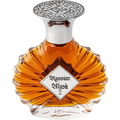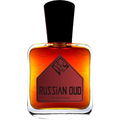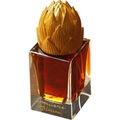05/22/2025

ClaireV
731 Reviews

ClaireV
1
Fizzy, vaporous oud with an iris tint
The History of Kinam Oud is a finished perfume (formula, compounding, and all) rather than a simple mixture of oud oil and ethanol. It is one of the most beautiful things I have smelled in a while, and I suspect that it would make even Luca Turin happy, because in re-framing the brutality of oud in the classically sedate architecture of French floral perfumery - cool, starched iris, powdery-gluey mimosa, even a touch of violets and mint - the oud becomes civilized, a simmering Heathcliff turned out in a dove-grey morning suit.
But before I get too far ahead of myself, let me take some time to break down the main building blocks. First, the iris, or more specifically, irone, a ketone extracted from the dried rhizome of the iris (orris root). Man, there is an expensive amount of it here. Sweet, starchy, doughy, and powdery all at once, this smells intensely of bread, wheat, violets, and the most expensive suede you can imagine. Chandler Burr once likened the scent of orris butter to 'liquid good taste'; smell this and you grasp what he means. In tenor, the orris butter element here strikes a similar tone to that in Iris Silver Mist (albeit less metallic/vegetal) and L'Atesa (minus the champagne-like aldehydes). Then, there's the mimosa, a small yellow flower that smells like glue, vegetable oil, yellow pollen, acacia honey, and dried sweetgrass (alfalfa). In History of Kinam, it shares that quality with orris root of being technically a floral and yet smelling very little of actual flowers and more like stuff like glue, cement, bread, leather, etc. Therefore, for any of you who noped out when I started talking about iris and mimosa, come back here right now! There is actually very little of the frilly femininity you are probably a little scared of.
The oud gets its own paragraph, so bear with me. This is not an overbearing or pushy oud accent. Rather, it fizzes around gently in the background, making you aware of its presence but only vaguely cognizant of this being an oud fragrance. The oud, which I understand to be a mix of wild Vietnamese and Chinese agarwood, appears as a vaporous mist of green, minty, and camphoraceous notes that make me think of those sparkling Borneo ouds with their bright silvery-greenness, all wood esters fizzing kinetically in the air off a freshly-cut piece of hinoki. The airy mien this creates makes sense when you realize that the perfume is mostly infused with the vapors of kinam oud rather than containing big greasy globules of oud oil itself. If anyone is reading this review and wondering what the hell kinam is, it is a grading term for a piece of agarwood that has been evaluated as superior quality even compared to the highest quality of wood in that particular area, so it is not a terroir per se. However, most kinam grade and kyara is traditionally found in the jungles of Vietnam, and particularly rare because Japanese incense companies buy up pretty much every inch of agarwood coming out of Vietnam.
Anyway, the medicinal gauze aspect of the oud vapors, the camphor, the orris butter - when these notes mingle together, something truly beautiful and refined emerges. I hesitate to trot out that over-used trope of a Florentine leather workman's shop on the Ponte Vecchio, but Kinam Oud is definitely pushing in that general direction. There is that whiff of timeless luxury you get when furtively huffing the insides of a Hermes Birkin, but also the thrilling, unmistakable bitterness of camphor and woodrot from the oud, which adds a touch of something wild that saves this from being a posh boutique scent. Not sure that there is a handy parallel I can make to a commercial or niche scent, but let's say that Feu Secret (Fzotic) with its camphor and orris, Royal Mayfair (Creed) with its rousing eucalyptus and a bit of that Creed ambergris (bitter, woody, slightly radiant, without being too obnoxiously Ambroxany) and New Sibet (fine-boned leather, orris, a mere suggestion of something animal lurking in the shadows) lie in the same general direction as History of Kinam Oud.
It dries down into a very hollow-smelling, dusty pleather note that I don't love. It smells brackish and anisic, like myrrh oil, but also like old tea leaves. The only thing I can think of that might be producing this effect is clary sage oil (the Irish ambergris that Adam uses is certainly not the culprit, because I know that to be sparkling and warm and alive smelling, like minerals pulsing with mammalian funk). Not my favorite end point ever, but there you go.
But before I get too far ahead of myself, let me take some time to break down the main building blocks. First, the iris, or more specifically, irone, a ketone extracted from the dried rhizome of the iris (orris root). Man, there is an expensive amount of it here. Sweet, starchy, doughy, and powdery all at once, this smells intensely of bread, wheat, violets, and the most expensive suede you can imagine. Chandler Burr once likened the scent of orris butter to 'liquid good taste'; smell this and you grasp what he means. In tenor, the orris butter element here strikes a similar tone to that in Iris Silver Mist (albeit less metallic/vegetal) and L'Atesa (minus the champagne-like aldehydes). Then, there's the mimosa, a small yellow flower that smells like glue, vegetable oil, yellow pollen, acacia honey, and dried sweetgrass (alfalfa). In History of Kinam, it shares that quality with orris root of being technically a floral and yet smelling very little of actual flowers and more like stuff like glue, cement, bread, leather, etc. Therefore, for any of you who noped out when I started talking about iris and mimosa, come back here right now! There is actually very little of the frilly femininity you are probably a little scared of.
The oud gets its own paragraph, so bear with me. This is not an overbearing or pushy oud accent. Rather, it fizzes around gently in the background, making you aware of its presence but only vaguely cognizant of this being an oud fragrance. The oud, which I understand to be a mix of wild Vietnamese and Chinese agarwood, appears as a vaporous mist of green, minty, and camphoraceous notes that make me think of those sparkling Borneo ouds with their bright silvery-greenness, all wood esters fizzing kinetically in the air off a freshly-cut piece of hinoki. The airy mien this creates makes sense when you realize that the perfume is mostly infused with the vapors of kinam oud rather than containing big greasy globules of oud oil itself. If anyone is reading this review and wondering what the hell kinam is, it is a grading term for a piece of agarwood that has been evaluated as superior quality even compared to the highest quality of wood in that particular area, so it is not a terroir per se. However, most kinam grade and kyara is traditionally found in the jungles of Vietnam, and particularly rare because Japanese incense companies buy up pretty much every inch of agarwood coming out of Vietnam.
Anyway, the medicinal gauze aspect of the oud vapors, the camphor, the orris butter - when these notes mingle together, something truly beautiful and refined emerges. I hesitate to trot out that over-used trope of a Florentine leather workman's shop on the Ponte Vecchio, but Kinam Oud is definitely pushing in that general direction. There is that whiff of timeless luxury you get when furtively huffing the insides of a Hermes Birkin, but also the thrilling, unmistakable bitterness of camphor and woodrot from the oud, which adds a touch of something wild that saves this from being a posh boutique scent. Not sure that there is a handy parallel I can make to a commercial or niche scent, but let's say that Feu Secret (Fzotic) with its camphor and orris, Royal Mayfair (Creed) with its rousing eucalyptus and a bit of that Creed ambergris (bitter, woody, slightly radiant, without being too obnoxiously Ambroxany) and New Sibet (fine-boned leather, orris, a mere suggestion of something animal lurking in the shadows) lie in the same general direction as History of Kinam Oud.
It dries down into a very hollow-smelling, dusty pleather note that I don't love. It smells brackish and anisic, like myrrh oil, but also like old tea leaves. The only thing I can think of that might be producing this effect is clary sage oil (the Irish ambergris that Adam uses is certainly not the culprit, because I know that to be sparkling and warm and alive smelling, like minerals pulsing with mammalian funk). Not my favorite end point ever, but there you go.




 Top Notes
Top Notes  Ambrette seed
Ambrette seed Clary sage absolute
Clary sage absolute Orris absolute
Orris absolute Vietnamese oud
Vietnamese oud Heart Notes
Heart Notes  Mimosa
Mimosa Base Notes
Base Notes  White ambergris
White ambergris
































